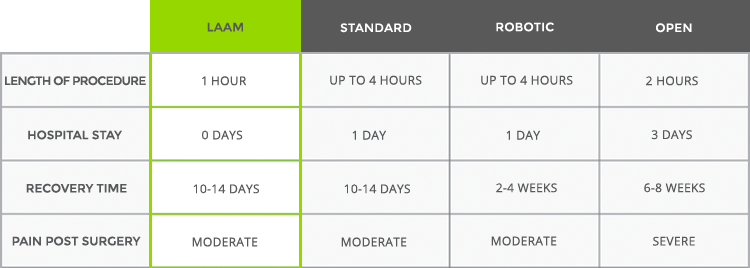
Fibroids


Fibroids do not diminish during or after menopause. Delaying surgery with this hope can be harmful.
What are uterine fibroids and who do they affect?
Uterine fibroids (also called myomas or leiomyomas) are noncancerous tumors that originate in the smooth muscle cells inside the wall of the uterus. Fibroids can occur anywhere in the uterus and grow either as a single tumor or in clusters. In both situations, the fibroids can vary in size from as small as an apple seed to a very large growth. As such, they can change the shape or size of the uterus and sometimes the cervix.
Who gets fibroids and what are the risk factors?
About 30 percent of women will get fibroids by age 35, and between 70 percent and 80 percent will do so by age 50. African American women develop fibroids two to three times more often than white and Hispanic women. Also, African American women develop problems with fibroids at an earlier age, with the fibroids growing faster, becoming larger, and causing more bleeding and anemia than in women of other races.
What are the symptoms of fibroids?
Fibroids can cause:
- Heavy bleeding during a woman’s period and cause anemia
- Reproductive problems, including infertility and miscarriage
- Abdominal pain or pressure
- Constipation
- Incontinence
- Frequent urination
- Pain during intercourse
- Lower back pain
Does the location of the fibroids cause different types of symptoms?
Yes. In fact, there are four types of fibroids, which are named for their location because the position has a direct impact on a woman’s symptoms and fertility. They include:
- Intramural fibroids, the most common form, are found in 70 percent of women of childbearing age. They begin as small nodules in the muscular wall of the uterus and with time, may expand inwards, decreasing the size of the uterine cavity. When this happens, intramural fibroids can increase bleeding during menstruation and may press on the bladder, which can cause pelvic pain, back pain, frequent urination, constipation, bloating, and indigestion.
- Submucosal fibroids are located just beneath the outer layer of the uterus and can cause severe bleeding, even if they are small, and interfere with a woman’s ability to conceive.
- Subserosal fibroids appear on the outer surface of the uterus and continue to grow outwards. This means they can take up space and push against other structures like the spine and pelvis, causing pelvic pressure and pain, and back pain.
- Pedunculated fibroids grow outside the wall of the uterus but are attached to the uterus by a narrow stalk. Because the stalk can twist, pedunculated fibroids can be very painful.
If I have fibroids, will I be able to have children?
Depending on the location and size of a woman’s fibroids, these growths can interfere with conception, prevent implantation of a fertilized egg, or obstruct the fallopian tubes, preventing the embryo from passing into the uterine cavity and implanting on the endometrial lining. Fibroids can also cause problems during pregnancy, including affecting the blood flow and preventing the fetus from growing properly and causing pre-term labor and birth.
To prevent these problems, women with fibroids who want to become pregnant should consider a type of GYN surgery called a myomectomy to remove them. In many cases, infertility specialists will refer patients for this surgery before attempting in vitro fertilization (IVF).
What are the treatment options for fibroids?
Among the treatment options for uterine fibroids are hormone therapy, radiological treatment and a type of surgery called myomectomy (fibroid removal) that can be performed either as open abdominal surgery or through minimally invasive laparoscopic surgery. Patients who are no longer interested in childbearing can also opt to have a hysterectomy.
What is a myomectomy?
Myomectomy is the surgical removal of fibroids from the uterus. This surgical procedure allows the uterus to be left in place and, for some women, makes pregnancy more likely than before. Depending on the location of the fibroids, the myomectomy can be done through the pelvic area or through the vagina and cervix.
After fibroids are removed through a myomectomy, women can expect to see a reduction in their symptoms and their chances of becoming pregnant may increase.
What advances are there in surgery to treat fibroids?
Board certified GYN surgeons at The Center for Innovative GYN Care have developed a pioneering surgical approach called LAAM-BUAO, which takes the best elements of both laparoscopic and open approaches for fibroid removal (myomectomy). LAAM (Laparoscopic Assisted Abdominal Myomectomy) uses two small incisions, one at the belly button and one at the bikini line. It is specifically designed for women seeking fertility. Women who are past childbearing may not be candidates for LAAM. LAAM is not limited by fibroid size, number, or location. BUAO (Bilateral Uterine Artery Occlusion) is the blockage of the uterine artery during the procedure to control bleeding. Due to the advantage of the surgeon being able to feel all of the fibroids, LAAM is the most thorough minimally invasive technique used for a myomectomy. Most LAAM procedures are done in an outpatient setting, and patients are able to return to their lives sooner than with open procedures.
What are the benefits of the LAAM-BUAO procedure?
In general, the LAAM-BUAO procedure takes approximately 1 hour (by comparison, standard open procedures are up to four hours), can be performed as an outpatient procedure and significantly reduces recovery time and surgical complications.
![]() The LAAM-BUAO procedure takes 1 hour… and can be performed as an outpatient procedure.”
The LAAM-BUAO procedure takes 1 hour… and can be performed as an outpatient procedure.”
Other common procedures to remove fibroids include an open myomectomy, which requires either making a horizontal incision above the public pubic bone or a vertical incision from just below the navel to the pubic bone, and a laparoscopic or robotic myomectomy, which are minimally invasive procedures that can remove fibroids on stalks or from the outside the uterus. While commonly offered by OB-GYNs, these procedures have major disadvantages.
Open myomectomies require much larger incisions, resulting in more pain and longer recovery times of 6 to 8 weeks. There is a much higher rate of complications as well. Choosing a standard laparoscopic or robotic procedure also can present challenges when the fibroids are very large or there are large numbers of fibroids in the uterus.
How long is recovery from surgery?
Recovery times vary from ten days to 6-8 weeks depending on the type of surgery. This chart details recovery time for a variety of surgical techniques.

Are there alternatives to surgery?
Depending on a woman’s symptoms and medical condition, fibroids can be treated with medications that regulate the menstrual cycle. While treating the symptoms of heavy bleeding and pelvic pressure, these medications do not eliminate fibroids. Types of medical therapy include hormones that block the effects of estrogen or progesterone, or reduce or eliminate the production of these hormones from the ovaries.
What should I ask my doctor if surgery is prescribed?
Before undergoing surgery, you will likely have many questions for your physician or surgeon. View our recommended questions to ask – and background information to help you weight the answers – below or download a printable version.
HOW WILL THE SURGERY BE PERFORMED?
There are two main surgical treatment options for removing fibroids: a myomectomy, which only removes the fibroids, and a hysterectomy, which removes the uterus and fibroids. The type of surgery you choose should be based on your individual health concerns and desire to have children in the future.
Within these two surgical options, OB-GYNs also perform a wide range of surgical techniques with significantly different incision lengths, recovery times, and risk of complications. For example, unlike standard laparoscopic and robotic techniques, a new myomectomy procedure called LAAM-BUAO, pioneered by board certified GYN surgeons at The Center for Innovative GYN Care, which takes the best elements of both laparoscopic and open approaches for fibroid removal – myomectomy. LAAM (Laparoscopic Assisted Abdominal Myomectomy) entails two small incisions, one at the belly button and one at the bikini line, and it can be performed on any patient regardless of fibroid size, number, or location. BUAO (Bilateral Uterine Artery Occlusion) is the blockage of the uterine artery during the procedure to control bleeding. Due to the advantage of the surgeon being able to feel all of the fibroids, LAAM is the most thorough minimally invasive technique used for a myomectomy. Most LAAM procedures are done in an outpatient setting, and patients are able to return to their lives sooner than with open procedures.
IS OPEN SURGERY RECOMMENDED?
Open myomectomies are still the mostly commonly performed surgery to remove fibroids, but the major disadvantage with this type of approach is that it requires a much larger incision than new, minimally invasive techniques, resulting in longer hospital stays, more pain during recovery and longer recovery times – patients often need six to eight weeks to recover. A LAAM procedure; however, can be conducted in an outpatient setting with no hospital stay, and women generally recover in 10-14 days.
HOW MANY TIMES HAS HE/SHE PERFORMED THIS SURGERY?
When it comes to any form of surgery, training, skill and practice matter, which is why GYN surgeons who specialize in minimally invasive surgery are the most qualified. The reality is that OB-GYNs are highly skilled obstetric practitioners, but very few perform GYN surgeries often enough to be surgical specialists. This is borne out by studies, which find that GYN surgery is commonly a secondary component of what an OB-GYN does.
WHAT HAVE OTHER PATIENTS EXPERIENCED AFTER THIS PROCEDURE?
Ask specific questions about recovery times and hospital stays. New, innovative procedures can be performed in an outpatient setting and generally require only 10-14 days to recover, not six to eight weeks.
HAS HE/SHE RECEIVED FELLOWSHIP TRAINING IN MINIMALLY INVASIVE GYN SURGERY?
While most OB-GYNs are highly trusted generalists, they spend most of their time focusing on obstetrics and basic GYN care and therefore, perform specialized GYN surgeries rarely. Be sure to choose a surgeon who has received comprehensive training and performs many minimally invasive surgeries to remove fibroids each year.
WILL POWER MORCELLATION BE USED TO REMOVE TISSUE DURING THE SURGERY?
This is an important question when considering fibroid removal surgery. The reason is because hidden uterine cancer called sarcoma can be spread through the abdomen and pelvis during surgery when the small motorized blades in these devices spin at high speed to cut the fibroids into small strips for removal. The Food and Drug Administration (FDA) now requires all surgeons to tell women in advance if the surgery involves a power morcellator and to get written consent before the surgery takes place. Today, new minimally invasive surgical options are available that do not involve power morcellation, such as LAAM-BUAO.
WILL ROBOTICS BE USED TO ASSIST WITH THE SURGERY?
Although the American Medical Association and other leading medical societies have issued statements discouraging robotic techniques due to much higher costs to patients without any medical advantages, robotics continue to be used in GYN surgeries. This is because robotic procedures “enable” an OB-GYN not well trained in laparoscopic GYN surgical techniques to complete a procedure through a “minimally invasive” approach. This is why women should ask if robotics will be used and seek a specially trained surgeon able to perform the latest minimally invasive surgical techniques without using robotics.
WHAT IS MY ANTICIPATED RECOVERY TIME?
Patients who undergo myomectomies using robotic and open techniques can expect recovery times of 2-4 weeks and 6-8 weeks respectively. By selecting newer, innovative techniques, patients can return to their normal daily routines in as little as 10-14 days.
WHAT ARE MY OTHER SURGICAL OPTIONS?
If your physician recommends an open or robotic procedure, ask why he or she would not recommend a conventional laparoscopic myomectomy or a newer technique like the LAAM-BUAO.


